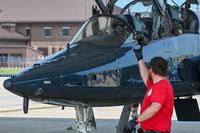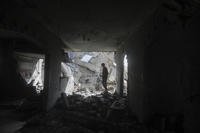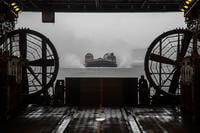
The Russian government is sending one of the world's largest warships into the Caribbean for a joint naval exercise with Venezuela. This will mark the first time since the end of the Cold War in December 1991 that a Russian naval force will sail that "American sea." The ships will operate in the Caribbean during November, showing support for Venezuela's government, which is strongly anti-United States.
Leading the Russian force will be the Petr Velikiy, a 26,000-ton, nuclear-propelled "battle cruiser." The ship, completed in 1998, is the world's largest warship other than aircraft carriers, and displaces more than twice as much as the largest U.S. surface combatants, the Aegis missile cruisers of the Ticonderoga (CG 47) class.
While Russian officials have denied that the deployment is linked to the United States sending naval ships into the Black Sea to visit a Georgian port, the Petr Velikiy cruise certainly reflects Prime Minister Vladimir Putin's efforts to demonstrate that Russia is again a major political-military "player" on the world scene. The single Russian aircraft carrier, the Admiral Kuznetsov, led a task force into the Mediterranean in late 2007, and there have been periodic long-range flights by Russian Bear bombers as the Putin regime seeks to impress other nations that Russia is still a great power. Admiral Eduard Baltin, former commander of Russia's Black Sea Fleet, said that the Caribbean maneuvers mean that "Russia is returning to the stage in its power and international relations which it, regrettably, lost at the end of last century".
"No one loves the weak," Baltin was quoted as saying by Russia's Interfax news agency.
Baltin, in January 2007, had declared that there was a buildup of U.S. nuclear-propelled submarines in the Persian Gulf area for the purpose of a Tomahawk missile strike against Iran.
"The presence of U.S. nuclear submarines in the Persian Gulf region means that the Pentagon has not abandoned plans for surprise strikes against nuclear targets in Iran. With this aim a group of multi-purpose submarines ready to accomplish the task is located in the area," he said.
There has been intense Russian interest in the Caribbean area since 1959, when Fidel Castro took control of Cuba and began negotiations with the Soviet Union for economic and military assistance. As the Soviets built up an arsenal of defensive and offensive weapons in Cuba in 1962, there were plans to dispatch cruisers and destroyers as well as submarines to the area to be based in Cuban ports. In the event, at the time of the crisis only a few Soviet diesel-electric submarines were in the area. Following the crisis additional conventional submarines visited the island's ports, with the first nuclear submarine arriving in 1969. Almost simultaneously a missile cruiser and two other surface combatants visited Cuba. Additional Soviet warships made periodic deployments into the Caribbean, including the helicopter carrier-missile cruiser Leningrad in 1984.
At the same time as these ship visit to Cuba, naval Bear reconnaissance/targeting aircraft made periodic flights from their Northern fleet bases, down the Atlantic, and landed in Cuba for short-term operations. They subsequently returned to their Soviet bases.
Such flights and warship visits came to an end with the demise of the Soviet Union.
The relatively modern destroyer Admiral Chabanenko (completed in 1999), probably another surface combatant, and an oiler will accompany the Petr Velikiy to the Caribbean. The nuclear-propelled warship is one of two remaining ships of a class of four "battle cruisers" at the Baltic Shipyard in St. Petersburg. The two other ships are no longer operational. These giant cruisers have combination oil-burning and nuclear propulsion plants that can drive them at 32 knots. They are armed with a massive array of anti-ship, anti-submarine, and air/missile defense weapons.








